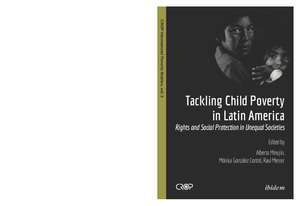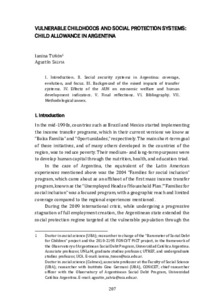Por favor, use este identificador para citar o enlazar este ítem:
https://repositorio.uca.edu.ar/handle/123456789/14437| Título: | Vulnerable childhoods and social protection systems: child allowance in Argentina | Autor: | Tuñón, Ianina Salvia, Agustín |
Palabras clave: | ASIGNACION UNIVERSAL POR HIJO; NIÑOS; DESIGUALDAD SOCIAL; POBREZA; PROTECCION SOCIAL; EXCLUSION SOCIAL; POLITICA ECONOMICA; POLITICA SOCIAL | Fecha de publicación: | 2017 | Editorial: | Ibidem-Verlag | Cita: | Tuñón, I., Salvia, A. Vulnerable childhoods and social protection systems: child allowance in Argentina [en línea]. En: Tackling child poverty in Latin America : rights and social protection in unequal societies. Stuttgart : Ibidem-Verlag, 2017. Disponible en: https://repositorio.uca.edu.ar/handle/123456789/14437 | Resumen: | In the mid-1990s, countries such as Brazil and Mexico started implementing the income transfer programs, which in their current versions we know as “Bolsa Familia” and “Oportunidades,” respectively. The main short-term goal of these initiatives, and of many others developed in the countries of the region, was to reduce poverty. Their medium- and long-term purposes were to develop human capital through the nutrition, health, and education triad. In the case of Argentina, the equivalent of the Latin American experiences mentioned above was the 2004 “Families for social inclusion” program, which came about as an offshoot of the first mass income transfer program, known as the “Unemployed Heads of Household Plan.”“Families for social inclusion” was a focused program, with a geographic reach and limited coverage compared to the regional experiences mentioned. During the 2009 international crisis, while undergoing a progressive stagnation of full employment creation, the Argentinean state extended the social protection regime targeted at the vulnerable population through the “Universal Allowance per Child for Social Protection” (AUH). This allowance was established by a Necessity and Urgency Decree [Argentina (Decree 1602/2009), 2009],2 and it constitutes a turning point in the social protection system. With the AUH, the Argentinean state acknowledges social inequality in the access to social protection, which is reflected in the duality between the population that belongs to the formal sector (with access to health coverage, retirement contributions, and work-related accidents insurance) and the population that has restricted access as a result of being part of the informal market, unemployed, or idle. In average, informal employment in Argentina between 2010 and 2012 affected 35% of the economically active population (PÉA). Without a doubt, here lies one of the main differences from other previous and current programs in the region. The eligibility criteria for the population are defined by the relationship of the parents with the job market. This transformation of the social security system was accompanied by the restructuring of the preexisting economic assistance programs to the extent that the creation of the AUH was accompanied by the immediate incorporation of children under 18 years from homes that up to that moment received income from social programs. It is estimated that, with the restructuring of the system, over 2.2 million children immediately became direct beneficiaries of the new scheme. In 2012, there were 3.5 million of children with AUH (1.9 million of participant households). The cash transfers of this allowance, along with the family pensions and the contributions from other municipally managed income transfer programs, represent between 0.6 and 0.8% of the GDP... | Cobertura Espacial: | Argentina | URI: | https://repositorio.uca.edu.ar/handle/123456789/14437 | ISBN: | 139783838269177 | Disciplina: | SOCIOLOGIA | Derechos: | Acceso abierto | Fuente: | Tackling child poverty in Latin America : rights and social protection in unequal societies. Stuttgart : Ibidem-Verlag, 2017. |
| Aparece en las colecciones: | Colaboraciones en ediciones externas |
Ficheros en este ítem:
| Fichero | Descripción | Tamaño | Formato | |
|---|---|---|---|---|
| vulnerable-childhood-social-protection-cover.pdf | 138,76 kB | Adobe PDF |  Visualizar/Abrir | |
| vulnerable-childhood-social-protection.pdf | 515,83 kB | Adobe PDF |  Visualizar/Abrir |
Visualizaciones de página(s)
65
comprobado en 27-abr-2024
Descarga(s)
76
comprobado en 27-abr-2024
Google ScholarTM
Ver en Google Scholar
Altmetric
Este ítem está sujeto a una Licencia Creative Commons

